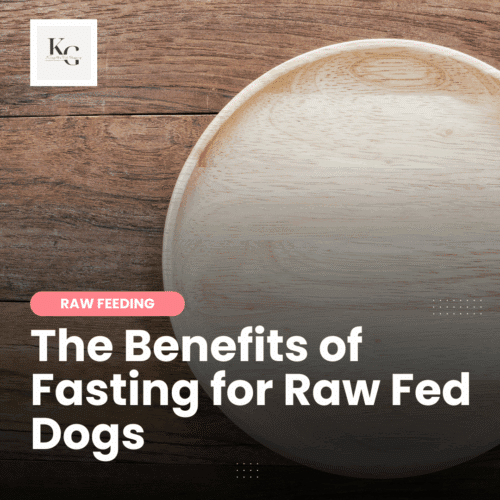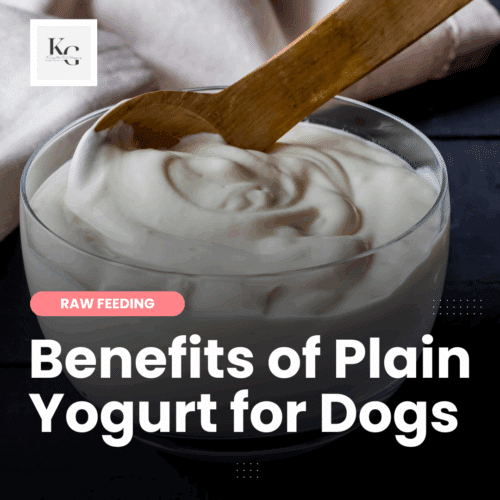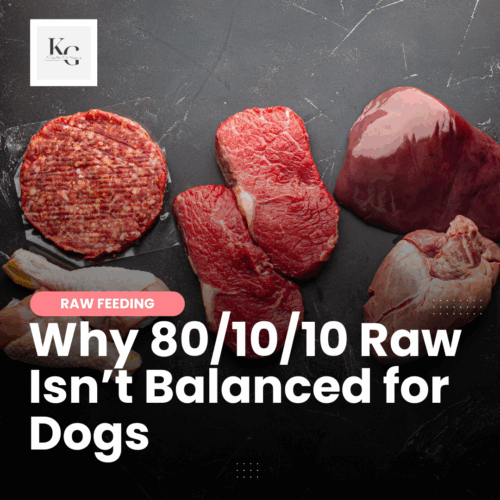Keep the Tail Wagging is supported by pet parents. I occasionally earn a commission (at no additional cost to you) when you click through an affiliate link to one of my favorite products. Thank you for your support. Read More
Like most dog owners, you want to feed your dog the best possible meals. That means understanding what ingredients provide the most nutritional benefit for your dog—especially regarding vegetables! Knowing which vegetables are the most nutritious can help you make healthier choices for your dog's meals. Let’s look at some of the most nutritious vegetables out there.
1 – Vegetables provide additional nutrients. From celery and cucumber to broccoli and okra, the suitable vegetables provide dogs with the vitamins, minerals, and fiber necessary to stay healthy. Feeding leafy greens such as kale, collard greens, lettuce, and bok choy is also good for providing dogs with iron, calcium, and more heart-healthy Vitamin A.
2 – Vegetables are a great source of fiber. Fiber can help improve digestion, enhance stool quality, and influence satiety, but it's also crucial for good overall health. Fibber helps ensure that nutrients are absorbed to their fullest extent and accelerates the elimination of harmful components in the gut, like toxins or bacteria. Plus, certain types of fiber may also protect against inflammatory diseases in dogs by serving as food for beneficial bacteria living in a healthy gut
3 – Vegetables are a great source of antioxidants. Leafy vegetables, such as collard greens, kale, and broccoli, are jam-packed with antioxidants, which incredibly benefit a dog's well-being. Antioxidant-rich foods can reduce autoimmune and allergy conditions in dogs, protect against disease and inflammation, reduce arthritis symptoms, enhance physical performance, and help to ensure a longer, healthier life for dogs.
4 – Vegetables are a great ingredient in a weight loss diet. Vegetables can be great tools to help dogs achieve their weight loss goals. Vegetables add low-calorie goodness to every bite, and the fiber helps keep dogs feeling full longer between meals.
5 – Fermented vegetables are a natural source of probiotics. Eating fermented foods provides our guts with certain probiotics that support the natural microflora in our digestive system for better gut health. It's also important to remember that these probiotics significantly impact a dog's well-being, too! This added support for a dog's gut health boosts their immune system and may contribute to their longevity.
Ways to Add Vegetables to a Dog's Diet
There is a lot of talk about the cellulose wall of vegetables. People believe that unless the cellulose wall of a vegetable is broken through predigestion (puree, freeze, or lightly cook), then the vegetable's nutrients cannot be absorbed by a dog's system. That being the case, I add vegetables to my dogs' diet in two ways
- I make a pureed vegetable blend that includes a variety of green and colorful vegetables.
- I ferment vegetables to add probiotics to support their gut health even more.
- Sometimes I feed thawed green beans or sweet potatoes to the bowl.
Vegetables I Feed to My Dogs
There are plenty of nutritious options for feeding your dog veggies! Each vegetable listed here provides unique benefits to support long-term health. Incorporating these into meals is easy to ensure your dog gets all the essential nutrients they need, so get creative with those recipes today!
1 – Carrots
Carrots are often touted as one of the healthiest vegetables for dogs, and rightfully so! They contain numerous vitamins and minerals, such as beta-carotene and Vitamin A, that work together to improve vision and immune system health.
Instead of buying organic carrots, like most raw feeders, I reach for Olewo carrots, a quality product made in Germany from 100% fresh, non-GMO carrots, with no additives, and preserved naturally through dehydration. Olewo carrots are recommended to cure diarrhea, but, as stated above, the beta-carotene and other nutrients make this supplement great for vision health and the immune system.
I add a small spoonful to my dogs' meals several times weekly.
2 – Collard Greens
Collard greens are also a great option since they contain high levels of vitamins A, C, and K that support bone health and strengthen immunity against diseases. I stopped feeding spinach because it is high in oxalates, a naturally occurring molecule that can lead to kidney stones if we feed too much to our dogs.
Plus, it smells awful when you add it to a ferment.
3 – Green Beans
Green beans offer dietary fiber, Vitamin K, and even some protein, making them an excellent source of nutrition for dogs. I add green beans to my dogs' dishes when they need to lose weight or during the cold winter months when the dogs aren't getting as much exercise to prevent excess weight gain.
4 – Sweet Potatoes
Sweet potatoes are packed with vitamins A, B6, C, E, calcium, and potassium. They are also rich in fiber, which supports gut health and helps keep dogs feeling full longer. I occasionally feed sweet potatoes as a treat, dehydrating them to make dog treats.
- I slice the sweet potatoes into strips or circles and blanch them for seven minutes to retain color.
- I dehydrate the treats for 6-7 hours at 135 F (57.2 C).
These steps will get you started, but you may have to adjust them based on the thickness of your slices and the dehydrator you are using.
5 – Broccoli
Broccoli contains fiber and vitamins A, C, and K, which help support overall health by aiding digestion and metabolism. While broccoli is terrific, broccoli sprouts are even better. I grow broccoli sprouts at home, dehydrate them for 6-7 hours at 110 F (43.3 C), and grind them into a natural powder supplement. I add it to my dogs' diet to fight cancer.
6 – Kale
And don’t forget about kale! It is packed with antioxidants that boost immunity and prevent disease-causing bacteria from entering your dog's body. I used to be big on kale, but I prefer collard greens (they're delicious) and dandelion greens.
7 – Cabbage
Cabbage contains compounds that may help reduce inflammation in dogs, and it's so easy to ferment. I pick up red and green cabbages when I plan to ferment them—they're colorful. But that's not all. Red cabbage is more nutritionally dense than green cabbage. It's also higher in Vitamins A and C and iron, while green cabbage is higher in Vitamin K.
8 – Cauliflower
Cauliflower is rich in nutrients like vitamin C and antioxidants that help fight infection. Cauliflower is a low-calorie food, making it a great alternative to green beans if your dog needs to lose a couple of pounds. If you make your veggie mix, skip the cauliflower or add very little. It doesn't smell great.
9 – Parsley
Finally, parsley is filled with powerful antioxidants that aid digestion and can even help reduce bad breath! It is also crazy easy to grow indoors and outdoors.
10 -Dandelion Greens
Dandelion greens promote healthy digestion, are filled with antioxidants, and boost the immune system. And they're free for many of us. We live on five acres of untreated grass. In the spring, I harvest dandelion greens and roots. I leave plenty of the bees digging up enough to clean and dehydrate my dogs.
What About Garlic?
Garlic didn't make my top ten because it's not a food I feed regularly. I add garlic to my veggie mix and a garlic supplement to my dogs' meals in the spring and summer to repel fleas, but it also has many other benefits. It takes a tremendous amount of garlic to reach toxic levels.
Benefits of Garlic for Dogs
- Garlic ruins the taste of dogs to fleas and ticks, acting as a natural repellent.
- Garlic in the bloodstream helps to boost the immune system while killing off cancer cells.
- Garlic strengthens the liver to do a better job detoxing the system.
- Garlic offers natural antibiotic properties that help to kill parasites and fight viral, bacterial, and fungal infections.
- Garlic supports heart healthy while reducing cholesterol.
But how much garlic is safe for dogs? Dr. Pitcairn shares the safe dosages in his book, The Complete Guide to Natural Health for Dogs and Cats.
- For dogs that weigh between 10-15 lbs – 1/2 clove
- For dogs that weigh between 20-40 lbs – 1 clove
- For dogs that weigh between 45-70 lbs – 2 cloves
- For dogs that weigh between 75-90 lbs – 2.5 cloves
- For dogs that weigh more than 100 lbs – 3 cloves
I add a full garlic bulb to a large batch (12 32-ounce glass jars) of veggie mix shared by several dogs weighing 60-75 pounds. This is far less than Dr. Pitcairn's above recommendations, which allows me to add more if I'd like.
The Study That Is Misleading Pet Parents
The study that has created so much confusion and fear surrounding feeding garlic to dogs was by KW Lee et al during which dogs were fed 5 grams of garlic for every 2.2 pounds (or 1 kilo) of body weight. That's about 132 grams of garlic for a 60-pound dog.
To put this into perspective, to reach toxic levels, I would need to feed my 60-pound dog 4-1/2 small bulbs of garlic (approx. 30 grams each) or 2-1/2 large bulbs of garlic (approx. 50 grams each). I would never do this because feeding a dog is an outrageous amount of garlic.
However, it's important to know that garlic should never be fed to puppies, pregnant dogs, or dogs with an anemic condition.
How to Add Vegetables to a Dog's Diet
People will tell you that dogs can't eat vegetables because they lack the digestive enzyme amylase, but this isn't true. While most mammals produce amylase in their saliva, amylase is produced by a dog's pancreas. It's not a lot, but it's there.
I feed vegetables to my dogs in several ways – pureed, dehydrated, fermented, and lightly cooked. You can also feed thawed vegetables as freezing breaks the cellular wall, making the nutrients more bioavailable.
Pureed Vegetables
The primary way I feed vegetables to my dogs is pureed. Because I wear a tin foil hat and don't trust the food industry, I alternate a vegetable blend in the summer with ingredients from my garden and local farmer's markets with a blend by Green JuJu Kitchen.
Although I use a base mix containing various vegetables, I occasionally add a tablespoon of pureed vegetables to their dish when feeding my dogs.
Dehydrated Vegetables
I use a dehydrated base mix from Dr. Harvey's to balance my dogs' raw diet. I dehydrate and blend certain vegetables to create a DIY supplement for my dogs; my favorite blend includes broccoli sprouts, dandelion greens, and parsley. And I dehydrate sweet potatoes and apply them to make healthy dog treats.
Fermented Vegetables
Fermented vegetables can easily boost a dog's gut health and immune system. Fermenting is easy to do, and using fermenting starter kits makes it easier. Plus, fermenting vegetables is an excellent alternative to digestive supplements. My favorite vegetable blends include carrots, collard greens, dandelion greens, and red and green cabbage.
Lightly Cooking Vegetables
Finally, I blanch vegetables for a few minutes and add them to my dogs' dishes as a side dish. I don't do this often because buying frozen vegetables, thawing them, and adding them to the dishes is easier. The freezing process breaks the cellular wall, making the nutrients more bioavailable. However, I don't often feed whole vegetables to my dogs; when I do, it's usually as a snack or to help a dog feel full.
I usually buy green beans, carrots, broccoli, sweet potatoes, and cauliflower. If the sweet potato cubes aren't a hit, try pureed sweet potatoes.
Why I Use a Base Mix
I began using a base mix to make raw feeding easier. The popular blend of 80% muscle meat, 10% bone, and 10% organ meat isn't enough to meet a dog's nutritional needs; however, combining those ingredients with a base mix gets us closer. Using a base mix saves me time and money and keeps me from feeling overwhelmed.
A certified canine nutritionist confirmed that my recipes are balanced, and a nutrient test confirmed that my dogs aren't deficient in vitamins or minerals.
What if a Dog Won't Eat Vegetables
Plenty of dogs won't eat vegetables; they eat around vegetables or pick them out and toss them on the floor. If you have a dog that isn't on the vegetable train, I recommend pureeing the vegetables and adding them to their raw blend (they can't pick these out) or using a base mix made of dehydrated vegetables. These are the easiest ways to add vegetables to their diet.
If you have more ideas or suggestions on other vegetables I should try, let me know in the comments below.







This is fantastic. I’m going to give this recipe a try. Thanks for sharing!!!
I lightly blanch fresh organic broccoli, carrots and a bit longer, boil up sweet potatoes w/skins cut into slices. I use the liquid I cook them in, adding all this to my blender with quinoa, frozen blueberries, organic applesauce and/or pumpkin (canned organic). I add basil, ginger, a tad of spirulina, & dulse, and next batch will add mushroom powders. After all this is blended up to be a thick yet creamy mixture (takes 2 blenders full) I add in large bowl raw, organic ground turkey (lots of it) mix thoroughly and dehydrate this mixture for jerky strips and scoop with ice cream scooper onto cookie sheets and freeze, which when thawed, make ‘the wet food’ She gets the dehydrated ‘crisps’ in the morning, we do a raw cornish hen bone around noon and at 5 pm she gets the wet mixture with minerals added and raw organic lambs liver and some raw cornish hen meat. It seems to be just fine, she loves all of it.
Your dog can eat edible mushrooms – the ones we buy in the store to cook for our meals are fine for dogs. It’s the mushrooms growing in the yard that you should be wary of.
Thanks for such an informational article. My dog does not like to eat vegetables. When I eat any dish that has mushrooms in it, he keeps on asking for that. What I have learnt so far is to keep your dog away from mushrooms. Is there any other way to make my dog eat vegetables?
Thank you, Sophia. I don’t recommend spinach for dogs; instead, I feed kale and collard greens.
I just read this article on 10 nutritious vegetables that dogs can eat, and I have to say, I learned a lot! As a dog owner, I’m always looking for ways to keep my pup healthy and happy, and incorporating more veggies into his diet sounds like a great option.
I love that the article emphasizes the importance of variety in a dog’s diet – just like humans, dogs need a range of nutrients to stay healthy. And the fact that these vegetables are all safe and healthy for dogs to eat is a huge plus.
I was particularly excited to see sweet potatoes on the list – they’re one of my dog’s favorite foods! I’ve also tried giving him carrots and green beans before, but I didn’t realize that veggies like broccoli and spinach were safe for him as well. It’s great to know that there are so many options out there.
One thing I appreciated about the article was the tips on how to prepare and serve the vegetables. I never would have thought to puree them or cook them with a little bit of oil to make them more palatable for my pup. These are great ideas that I’ll definitely be trying out in the future.
Overall, I’m grateful for the information in this article and I’m excited to experiment with more veggies in my dog’s diet. Thanks for sharing this helpful information! ??